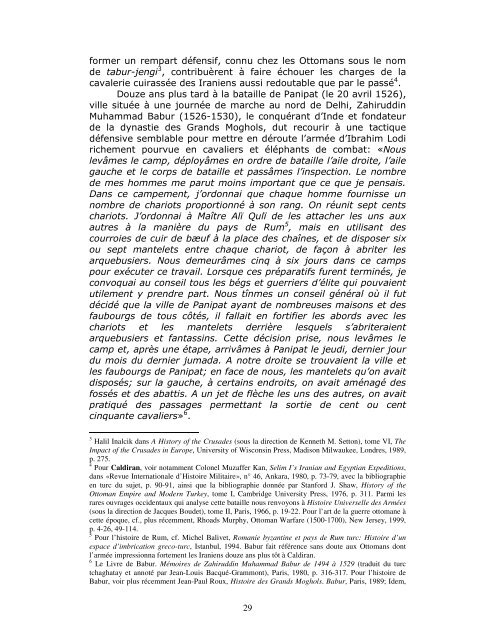Cet ouvrage a été publié avec le concours et le ... - Cour de France.fr
Cet ouvrage a été publié avec le concours et le ... - Cour de France.fr
Cet ouvrage a été publié avec le concours et le ... - Cour de France.fr
You also want an ePaper? Increase the reach of your titles
YUMPU automatically turns print PDFs into web optimized ePapers that Google loves.
former un rempart défensif, connu chez <strong>le</strong>s Ottomans sous <strong>le</strong> nom<br />
<strong>de</strong> tabur-jengi 3 , contribuèrent à faire échouer <strong>le</strong>s charges <strong>de</strong> la<br />
cava<strong>le</strong>rie cuirassée <strong>de</strong>s Iraniens aussi redoutab<strong>le</strong> que par <strong>le</strong> passé 4 .<br />
Douze ans plus tard à la batail<strong>le</strong> <strong>de</strong> Panipat (<strong>le</strong> 20 avril 1526),<br />
vil<strong>le</strong> située à une journée <strong>de</strong> marche au nord <strong>de</strong> Delhi, Zahiruddin<br />
Muhammad Babur (1526-1530), <strong>le</strong> conquérant d’In<strong>de</strong> <strong>et</strong> fondateur<br />
<strong>de</strong> la dynastie <strong>de</strong>s Grands Moghols, dut recourir à une tactique<br />
défensive semblab<strong>le</strong> pour m<strong>et</strong>tre en déroute l’armée d’Ibrahim Lodi<br />
richement pourvue en cavaliers <strong>et</strong> éléphants <strong>de</strong> combat: «Nous<br />
<strong>le</strong>vâmes <strong>le</strong> camp, déployâmes en ordre <strong>de</strong> batail<strong>le</strong> l’ai<strong>le</strong> droite, l’ai<strong>le</strong><br />
gauche <strong>et</strong> <strong>le</strong> corps <strong>de</strong> batail<strong>le</strong> <strong>et</strong> passâmes l’inspection. Le nombre<br />
<strong>de</strong> mes hommes me parut moins important que ce que je pensais.<br />
Dans ce campement, j’ordonnai que chaque homme fournisse un<br />
nombre <strong>de</strong> chariots proportionné à son rang. On réunit sept cents<br />
chariots. J’ordonnai à Maître Alï Qulï <strong>de</strong> <strong>le</strong>s attacher <strong>le</strong>s uns aux<br />
autres à la manière du pays <strong>de</strong> Rum 5 , mais en utilisant <strong>de</strong>s<br />
courroies <strong>de</strong> cuir <strong>de</strong> bæuf à la place <strong>de</strong>s chaînes, <strong>et</strong> <strong>de</strong> disposer six<br />
ou sept mante<strong>le</strong>ts entre chaque chariot, <strong>de</strong> façon à abriter <strong>le</strong>s<br />
arquebusiers. Nous <strong>de</strong>meurâmes cinq à six jours dans ce camps<br />
pour exécuter ce travail. Lorsque ces préparatifs furent terminés, je<br />
convoquai au conseil tous <strong>le</strong>s bégs <strong>et</strong> guerriers d’élite qui pouvaient<br />
uti<strong>le</strong>ment y prendre part. Nous tînmes un conseil général où il fut<br />
décidé que la vil<strong>le</strong> <strong>de</strong> Panipat ayant <strong>de</strong> nombreuses maisons <strong>et</strong> <strong>de</strong>s<br />
faubourgs <strong>de</strong> tous côtés, il fallait en fortifier <strong>le</strong>s abords <strong>avec</strong> <strong>le</strong>s<br />
chariots <strong>et</strong> <strong>le</strong>s mante<strong>le</strong>ts <strong>de</strong>rrière <strong>le</strong>squels s’abriteraient<br />
arquebusiers <strong>et</strong> fantassins. <strong>C<strong>et</strong></strong>te décision prise, nous <strong>le</strong>vâmes <strong>le</strong><br />
camp <strong>et</strong>, après une étape, arrivâmes à Panipat <strong>le</strong> jeudi, <strong>de</strong>rnier jour<br />
du mois du <strong>de</strong>rnier jumada. A notre droite se trouvaient la vil<strong>le</strong> <strong>et</strong><br />
<strong>le</strong>s faubourgs <strong>de</strong> Panipat; en face <strong>de</strong> nous, <strong>le</strong>s mante<strong>le</strong>ts qu’on avait<br />
disposés; sur la gauche, à certains endroits, on avait aménagé <strong>de</strong>s<br />
fossés <strong>et</strong> <strong>de</strong>s abattis. A un j<strong>et</strong> <strong>de</strong> flèche <strong>le</strong>s uns <strong>de</strong>s autres, on avait<br />
pratiqué <strong>de</strong>s passages perm<strong>et</strong>tant la sortie <strong>de</strong> cent ou cent<br />
cinquante cavaliers» 6 .<br />
3 Halil Inalcik dans A History of the Crusa<strong>de</strong>s (sous la direction <strong>de</strong> Kenn<strong>et</strong>h M. S<strong>et</strong>ton), tome VI, The<br />
Impact of the Crusa<strong>de</strong>s in Europe, University of Wisconsin Press, Madison Milwaukee, Londres, 1989,<br />
p. 275.<br />
4 Pour Caldiran, voir notamment Colonel Muzaffer Kan, Selim I’s Iranian and Egyptian Expeditions,<br />
dans «Revue Internationa<strong>le</strong> d’Histoire Militaire», n° 46, Ankara, 1980, p. 73-79, <strong>avec</strong> la bibliographie<br />
en turc du suj<strong>et</strong>, p. 90-91, ainsi que la bibliographie donnée par Stanford J. Shaw, History of the<br />
Ottoman Empire and Mo<strong>de</strong>rn Turkey, tome I, Cambridge University Press, 1976, p. 311. Parmi <strong>le</strong>s<br />
rares <strong>ouvrage</strong>s occi<strong>de</strong>ntaux qui analyse c<strong>et</strong>te batail<strong>le</strong> nous renvoyons à Histoire Universel<strong>le</strong> <strong>de</strong>s Armées<br />
(sous la direction <strong>de</strong> Jacques Boud<strong>et</strong>), tome II, Paris, 1966, p. 19-22. Pour l’art <strong>de</strong> la guerre ottomane à<br />
c<strong>et</strong>te époque, cf., plus récemment, Rhoads Murphy, Ottoman Warfare (1500-1700), New Jersey, 1999,<br />
p. 4-26, 49-114.<br />
5 Pour l’histoire <strong>de</strong> Rum, cf. Michel Baliv<strong>et</strong>, Romanie byzantine <strong>et</strong> pays <strong>de</strong> Rum turc: Histoire d’un<br />
espace d’imbrication greco-turc, Istanbul, 1994. Babur fait référence sans doute aux Ottomans dont<br />
l’armée impressionna fortement <strong>le</strong>s Iraniens douze ans plus tôt à Caldiran.<br />
6 Le Livre <strong>de</strong> Babur. Mémoires <strong>de</strong> Zahiruddin Muhammad Babur <strong>de</strong> 1494 à 1529 (traduit du turc<br />
tchaghatay <strong>et</strong> annoté par Jean-Louis Bacqué-Grammont), Paris, 1980, p. 316-317. Pour l’histoire <strong>de</strong><br />
Babur, voir plus récemment Jean-Paul Roux, Histoire <strong>de</strong>s Grands Moghols. Babur, Paris, 1989; I<strong>de</strong>m,<br />
29


